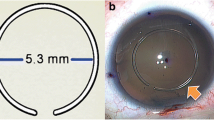Abstract
• Background: After curvilinear capsulorhexis in cataract surgery often a double-ring shape of the remaining capsular margins can be observed. In order to better understand this phenomenon we performed a histological study of excised capsules after continuous curvilinear capsulorhexis. • Methods: Ten anterior capsular specimens from cases with double-ring structure of the capsular margins after continuous curvilinear capsulorhexis (D-group) were examined light microscopically and compared with 10 normal cases (N-group) and 10 cases with pseudoexfoliation (P-group). Three cases from each group were also examined electron microscopically. • Results: A characteristic step formation in the capsular edges and in addition horizontal capsular splits in the border zone between the zonular lamella of the anterior capsule and the capsule proper could be demonstrated histologically in the D-group. • Conclusions: There seems to be a weak point of the capsular tissue in the border zone between zonular lamella of the lens and the capsule proper. The superficial splits that we found histologically in this region might be a precursor or forme fruste of true exfoliation. The outward-directed traction force exerted by the zonular fibers seems to lead to further disruption in this weakened layer of the lens capsule during capsulorhexis, producing a double-ring contour of the capsular margins.
Similar content being viewed by others
References
Assia EL, Apple DJ, Tsai JC, Morgan RC (1991) Mechanism of radial tear formation and extension after anterior capsulectomy. Ophthalmology 98:432–437
Assia EI, Apple DJ, Barden A, Tsai JC, Castenada VF, Hoggatt JS (1991) An experimental study comparing various anterior capsulectomy techniques. Arch Ophthalmol 109:642–647
Braude LS, Edward DP (1995) Partial splitting of the anterior lens capsule giving a “double-ring” sign. Arch Ophthalmol 113:705–706
Burde RM, Bresnick G, Uhrhammer J (1969) True exfoliation of the lens capsule. Arch Ophthalmol 82:651–653
Cashwell F, Holleman IL, Weaver CG, van Rens GH (1989) Idiopathic true exfoliation of the lens capsule. Ophthalmology 96:348–351
Duke-Elder S (1969) The anatomy of the visual system. (System of ophthalmology, vol 11) Kimpton, London, pp 314–315
Dvorak-Theobald G (1954) Pseudoexfoliation of the lens capsule. Relation to “true” exfoliation of the lens capsule as reported in the literature and role in the production of glaucoma capsulocuticulare. Am J Ophthalmol 37:1–12
Karnovsky MJ (1965) A formaldehyde-glutaraldehyde fixative of high osmolarity for use in electron microscopy. J Cell Biol 27:137a
Neubann Th (1987) Theorie und Operationstechnik der Kapsulorhexis. Klin Montsbl Augenheilkd 190:542–545
Naumann GOH (1995) The Bowman Lecture. Eye 9:395–421
Author information
Authors and Affiliations
Rights and permissions
About this article
Cite this article
Wollensak, G., Wollensak, J. Double contour of the lens capsule edges after continuous curvilinear capsulorhexis. Graefe's Arch Clin Exp Ophthalmol 235, 204–207 (1997). https://doi.org/10.1007/BF00941760
Received:
Revised:
Accepted:
Issue Date:
DOI: https://doi.org/10.1007/BF00941760




